- »
- báo cáo »
- Reports »
- Understanding China’s fish trade and traceability
China’s fisheries must adapt to meet new EU regulations
Beijing, China, 17th August 2009—China appears to have made considerable progress in improving the traceability of its fish processing industry, but will need to adapt further if it is to meet the requirements of forthcoming European Union regulations, according to a new report by TRAFFIC, the wildlife trade monitoring network.
Understanding China’s fish trade and traceability
Report author(s):
S. Clarke
Publication date:
August 2009
key findings

From January 2010, all fish materials imported into the European Union (EU) will have to be accompanied by catch certificates. The certificates will then have to be validated by the flag State of the vessel that caught the fish. The new laws aim to combat Illegal, Unregulated and Unreported (IUU) fishing.
The ability of China, as the leading exporter of marine fish products and the world’s fastest growing major economy, to meet such requirements is regarded as vital in the process to curb IUU fishing worldwide.
The TRAFFIC study, Understanding China’s fish trade and traceability, characterizes China’s fish reprocessing industry and examines to what extent its existing traceability systems will be able to cope with the requirements of the forthcoming EU legislation.
The study was funded by the UK Government’s Department for Environment, Food and Rural Affairs (DEFRA).
“The UK government was pleased to be able to assist our colleagues in China to understand the implications of the forthcoming EU legislation and how we could work together to implement the new laws,” said Huw Irranca-Davies, UK fisheries minister.
To meet the new requirements for exporting to the EU, China will have to issue certificates for all catches by China-flagged vessels, and obtain certificates from other countries when fish is imported into China for processing.
“The welcome initiative by the EU to tackle IUU fishing, along with measures being introduced in the US, mean that the days are rapidly disappearing for those who trade in seafood products without adequate documentation to prove the legitimacy of their operations,” said Glenn Sant, TRAFFIC’s Global Marine Programme Leader.
 The study compiled information on the structure of the current fish processing trade for marine species caught or reprocessed by mainland China, and examined the fish documentation schemes in place to look for weaknesses where infiltration of illegally sourced fish might occur.
The study compiled information on the structure of the current fish processing trade for marine species caught or reprocessed by mainland China, and examined the fish documentation schemes in place to look for weaknesses where infiltration of illegally sourced fish might occur.
“By illuminating the role China plays in fish reprocessing, the report highlights the extent to which China must be involved in solutions to the problems of overfishing and IUU catches,” said Shelley Clarke, author of the report.
China’s fish processing industry has grown rapidly: in 1993, China’s annual production of fishery products totaled only 2.8 million tonnes but by 2006 production had increased to 9.3 million tonnes. The industry is based primarily in Shandong and Liaoning Provinces, and there are roughly 9,000 re-processing plants in operation.
Species examined in the report include pollock, cod, salmon, redfish, haddock, whiting, coalfish, hake, toothfish and tuna. It is estimated that more than half of the raw materials for China’s re-processing industry derive from the Russian Federation including major inputs of cod and salmon as well as large quantities of imported “unspecified” fish.
However, determining the quantities of species of fish being re-processed is far from straightforward: Customs systems both in China and in some importing countries lack sufficient detail in commodity codes and usually do not check whether fish imports are classified under the appropriate code.
Another complication is that owing to the complexity of the industry, fish may legally change hands several times whilst in China, with obvious implications for product traceability.
Recommendations in the report include streamlining of the monitoring systems currently used by Chinese authorities into a single, integrated and effective traceability system; the development of formal requirements for catch certification and documentation in China; additional assistance from the EU and others to help China comply with new legislation being introduced and to provide intelligence for fisheries enforcement in countries which may be the source of imported IUU fish into China.
Understanding China’s fish trade and traceability by Shelley Clarke was published by TRAFFIC East Asia and the project was funded by the UK Government’s Department for Environment, Food and Rural Affairs (DEFRA).
The new Illegal, Unreported and Unregulated (IUU) Fishing Regulation (Council Regulation (EC) No 1005/2008) comes into force on 1st January 2010 and contains some important new rules concerning imports and exports of fish and fish products to and from the EU.
January 2010
the date by which all fish materials imported into the EU will have to be accompanied by catch certificates.
9.3 million tonnes
China’s annual production of fishery products in 2006
~9,000 plants
for re-processing operate in China, based primarily in Shandong and Liaoning Provinces.
for more information:
Media Team
+44 7542 229210





